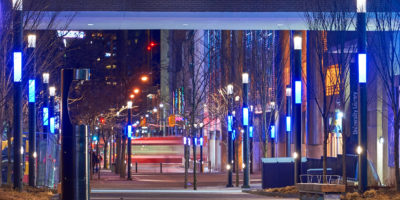By Nicole Cohen
Ryerson is getting set to embark on its largest building blitz in decades, but skyrocketing costs in the construction industry may force administrators to downsize some of their plans.
The university will be surrounded by hard hats, cranes and debris as construction crews erect three new buildings and renovate two others on campus over the next few years, the same time the rest of the city will find itself in the middle of a building boom.
“We have to be very careful to balance the scope of the projects with available funds,” said Ian Hamilton, Ryerson’s director of campus planning and facilities.
Ryerson is in the process of getting three SuperBuild projects off the ground — buildings that will be constructed with the help of $54-million in provincial government funding — as well as a new student centre and renovations to 297 Victoria St. for the continuing education division. The SuperBuild initiatives are a facility for computing and engineering, a graphic communications management centre and a joint program in community health services with George Brown College.
All of these projects come at the same time as massive hospital and condominium construction in the city, $4.1-billion worth of renovations to Pearson International Airport and a $150-million redevelopment project at the corner of Yonge and Dundas Streets.
This means Ryerson may have to pay more for its contractors and materials because there will be a greater demand for them.
“Materials and labour are in short supply and high demand,” said Tim Harris, president of the Toronto Construction Association.
To prepare for the potential cost increases, Hamilton said the university has put aside 10 per cent of its building budget — somewhere in the neighbourhood of $10-million — but that may not be enough.
He said he relies on updates from surveying companies to determine whether the school will have to downsize its projects because of increased costs.
Linda Grayson, the university’s v.p. administration and students affairs, said Ryerson won’t know until at least Match whether its SuperBuild projects will need more money. That’s when all building designs are scheduled to be finished.
“When the rubber hits the road,” she said, “that’s when we’ll have a really good idea is we’re on target or off target.”
If the budgets are off target, Grayson is confident Ryerson won’t be left scrambling.
“There are ways to cut costs,” she said. “We’ll look at things that would be nice to have but not absolutely essential,” which could include downgrading the quality of building supplies and using fewer furnishings and equipment than originally planned.
Universities are hoping the provincial government will chip in more money to pay for the potential extra costs, said Mark Sterling of Sterling Finlayson Architects, one of the urban planning consultants for Ryerson’s engineering and computer science building.
“People are in an optimistic mode that the provincial government will respond with money,” he said. “Today’s dollar will be different from 2003’s dollar.”
But Hamilton says the Ministry of Training, Colleges and Universities probably won’t entertain requests made for more funds.









Leave a Reply